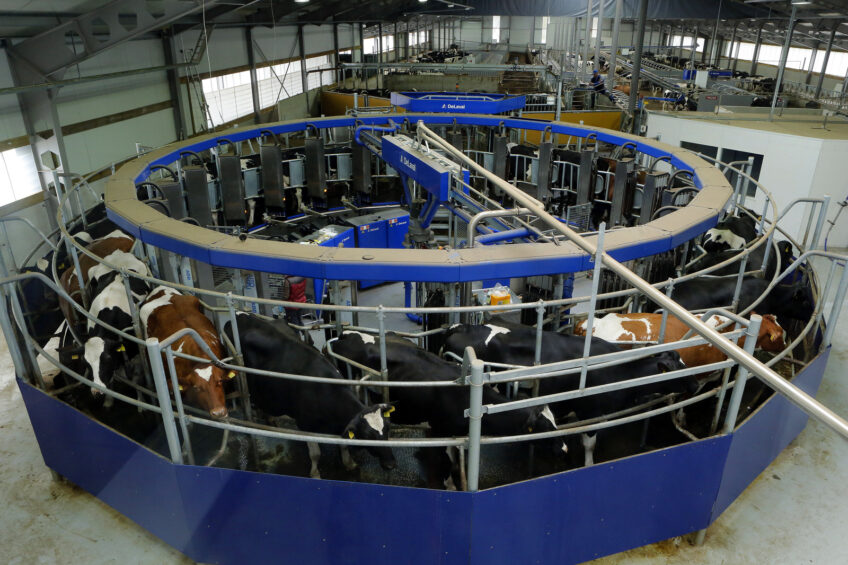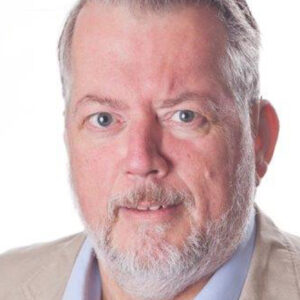Finns invest €5 million to optimise dairy farm

€5 million – that is what Juhani Korkiamäki and Ari Teppo invested in their new company FinnMilk. For that, they got a new location, 2 stables for a total of 600 dairy cows, a calf barn with 40 crates and 80 calves in groups.
The rotary parlour is fully robotised, there is a large shed in which a hammer mill is housed, a few hundred tonnes of grain storage with a receiving bin, forage storage in 5 silos of 12 x 64 meters and 2 manure silos of 3,500 cubic meters each. And all this neatly surrounded by a large fence. In short: a company where everyone would love to farm: brand new buildings, built according to the latest insights and financially sound.
The new location houses only calves up to approximately 3 months of age. Heifers are not present. They are on the former 2 dairy farms of the 2 entrepreneurs. That is also where most of the forage is stored. Those 2 companies are about 45 km apart, the new location is halfway realised.
From mega to the largest dairy farm in Finland
The average Finnish dairy farm has less than 30 cows. That makes the merging of 2 ‘mega’ companies to the biggest Finnish dairy farm quite special. The merger started after a visit to EuroTier in 2012. On the return flight Korkiamäki and his friend Teppo took the calculator and a notepad. Korkiamäki then milked 130 cows on two robots, Teppo 200 cows on three robots. They were shocked by the outcome of merging their farms and building new. “There were a lot of hidden efficiencies,” added Korkiamäki. “The next day we told our wives. Katja knew that I wanted to expand the farm size. She also knew very well that in the construction phase running the ‘old’ company would be completely down to her. Not a problem, because she is a better farmer than I am. I’m more of a manager. She gave me her blessing after some thought. Ari’s wife is less involved in the farm, she works completely outside the company. She also agreed immediately. The next Monday we called the bank that gave us the green light right away. We should start to make a business plan and make things concrete. A year later the first shovel went into in the ground.”

Katja (35) and Juhani (37) Korkiamäki and Ari Teppo (44) have their farm in Seinajoki, Finland. FinnMilk keeps 450 cows on 450 hectares of grassland. Of this, 200 hectare are owned and 250 acres are leased for 5 to 10-year, at a lease of approximately €260 per hectare per year. The cows produce 10,100 kg of milk per lactation with 3.75% fat and 3.30% protein.
New location
FinnMilk, in which Korkiamäki and Teppo each have 49.5% of the shares and a third person mainly for tax reasons 1%, bought a new location about halfway the two old locations. “The first condition for us was that it was located on the main road. We have too many transport movements, we have to have quick snow-free access.” Because of the height difference in the lot 66,000 cubic meters of sand had to be moved by truck. The site preparation took almost a year; the construction, mostly with prefabricated parts, took only 4 months. February 2015, the 330 own cows and heifers went to the new company. Since then, more than 100 heifers were purchased and added. The acquired animals were not brought into the new barn before blood tests showed that they are free of IBR, BVD and Salmonella. “We are free of those diseases and we want to stay that way,” says Juhani Korkiamäki. “Therefore, any visitor must wear work clothing and footwear provided by us. Visitors may only come on the feed paths, not on slatted floors or between animals. In addition, the calf barn is a ‘forbidden area’.

Two large stables and a small barn
The design of FinnMilk differs not much from other large enterprises. The cows are housed in two large stables that are next to each other and are connected by a corridor. The stable on the left houses four groups of 120 cows. At present, 3 are in use. The right-hand stable houses a group of 70 attention cows and up to 100 dry cows. The cows in the attention group have 50% more space than the cows in the left-hand stable. The dry cows and the cows in the attention group are housed on straw bedding, all other cattle on concrete floors with an automated manure scraper. In the front court is a stable space for up to 20 cows whose milk is to be kept separate: the fresh cows and animals treated with antibiotics. These animals are milked in a VMS milking robot. “That one comes from Ari’s old farm, the other robots from his company and mine have been sold.”
Automatic Milking Rotary
The barn on the right side also houses a waiting area with room for 140 cows and an AMR, an Automatic Milking Rotary, the fully automated rotary parlour that Delaval recently started selling. The inside milker with 24 booths now runs about 14 hours per day. The group of 120 highly productive cows and the attention group 3 times a day; the other cows go through the carousel twice a day. Due to the new system and the large number of heifers that are new in the group there are quite a bit of scary cow-reactions in the AMR rotary milking. “Therefore, someone must be present while milking. I estimate that that won’t be necessary anymore about 6 weeks from now. The milking robots can than run unattended,” says the Finn.
No automatic cattle feeding system
The company is set up for a minimal labour demand. Korkiamäki and Teppo are the managers who focus on monitoring and feeding the animals. “The 4 employees are among the animals and look at individual animals, we look at the conduct of groups, from the top,” said Korkiamäki. “That reinforces each other so.” The cows are fed with a feed mixer wagon. Robot feeding was considered in the design of the new location but eventually dropped. “A big producer of robotic feeding is not far from here and wanted to supply almost at any cost. Its products are fine, but not for this type of farm. If the feeding stops here, the problems are big. A faulty feed mixer wagon can easily be replaced, with a faulty robot system there is no alternative. That risk was too great.”

Management of personnel
The entrepreneurs stay away from risks as much as possible. For instance by installing a 1,000 kWh backup generator. It runs more than expected. Not because the power goes off completely, but to compensate for alternating voltages. Another risk, management of personnel, for the experienced entrepreneurs this is not a problem. Teppo always worked with two assistants, Korkiamäki had a leadership role in the field at Delaval. “Leadership is not new to us. Treat others as you want to be treated, but remember to also lead them. They have freedom in their work, but should do the job the way you want it done.”
The division of tasks between the two executives has grown rapidly and is responding to both interests. Korkiamäki does general management, Teppo focuses on nutrition. “He applies the rations on the basis of intake, milk production, and the colour of the manure.” The two can take each other’s role during holidays. “I was skiing a few weeks ago with my wife and kids,” says Korkiamäki. “It was the first holiday in ten years that my mobile hasn’t rung for the business.”
Healthy financing buffer
The investment was, apart from the animals, €5 million. Of that, €1 million was subsidised and €1.2 million came from own resources. That brought the necessary additional funding to €2.8 million. At the current low interest rates, less than 2.5%, and repayment in 20 years that means financing costs of 3 to 4 cents per kilo of milk, if the company is in full production. “Our long term milk price is 40 cents,” says the Finn. “We have counted with a much lower price, 35 cents per kilogram. At this time we receive below that because exports of milk to Russia, Finland’s main customer, has stalled. This will not lead to problems. Our maximum risk is determined at a milk price of 30 cents for a year. On that basis buffers were formed. And when the price goes up again? Then we accelerate repayments to the bank and pay the shareholders a dividend so we get our own resources back.”
Join 13,000+ subscribers
Subscribe to our newsletter to stay updated about all the need-to-know content in the dairy sector, two times a week.










